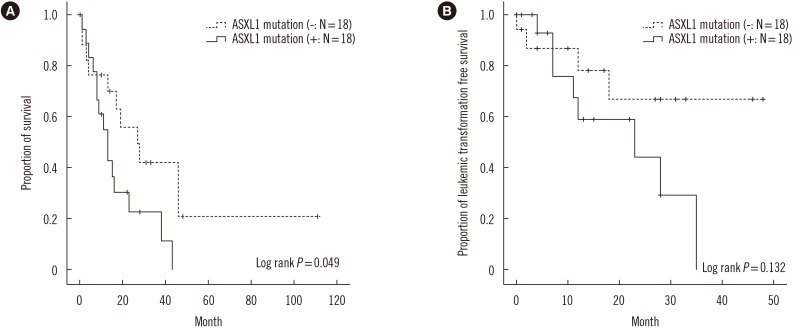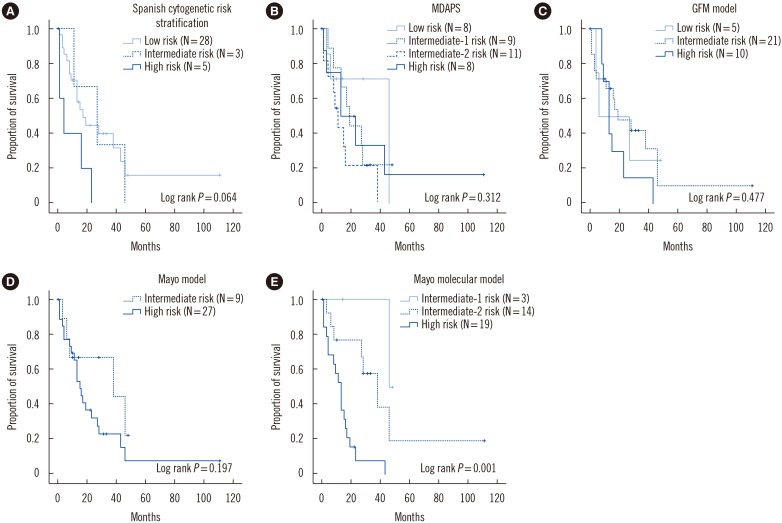Ann Lab Med.
2018 Nov;38(6):495-502. 10.3343/alm.2018.38.6.495.
Poor Prognostic Implication of ASXL1 Mutations in Korean Patients With Chronic Myelomonocytic Leukemia
- Affiliations
-
- 1Department of Laboratory Medicine & Genetics, Samsung Medical Center, Sungkyunkwan University School of Medicine, Seoul, Korea. heejinkim@skku.edu
- 2Department of Laboratory Medicine, Gyeongsang National University Hospital, Gyeongsang National University School of Medicine, Jinju, Korea.
- 3Samsung Biomedical Research Institute, Samsung Medical Center, Sungkyunkwan University School of Medicine, Seoul, Korea.
- 4Division of Hematology-Oncology, Department of Medicine, Samsung Medical Center, Sungkyunkwan University School of Medicine, Seoul, Korea.
- KMID: 2429113
- DOI: http://doi.org/10.3343/alm.2018.38.6.495
Abstract
- BACKGROUND
Molecular genetic abnormalities are observed in over 90% of chronic myelomonocytic leukemia (CMML) cases. Recently, several studies have demonstrated the negative prognostic impact of ASXL1 mutations in CMML patients. We evaluated the prognostic impact of ASXL1 mutations and compared five CMML prognostic models in Korean patients with CMML.
METHODS
We analyzed data from 36 of 57 patients diagnosed as having CMML from January 2000 to March 2016. ASXL1 mutation analysis was performed by direct sequencing, and the clinical and laboratory features of patients were compared according to ASXL1 mutation status.
RESULTS
ASXL1 mutations were detected in 18 patients (50%). There were no significant differences between the clinical and laboratory characteristics of ASXL1-mutated (ASXL1+) CMML and ASXL1-nonmutated (ASXL1−) CMML patients (all P>0.05). During the median follow-up of 14 months (range, 0-111 months), the overall survival (OS) of ASXL1+ CMML patients was significantly inferior to that of ASXL1− CMML patients with a median survival of 11 months and 19 months, respectively (log-rank P=0.049). An evaluation of OS according to the prognostic models demonstrated inferior survival in patients with a higher risk category according to the Mayo molecular model (log-rank P=0.001); the other scoring systems did not demonstrate a significant association with survival.
CONCLUSIONS
We demonstrated that ASXL1 mutations, occurring in half of the Korean CMML patients examined, were associated with inferior survival. ASXL1 mutation status needs to be determined for risk stratification in CMML.
Keyword
MeSH Terms
Figure
Reference
-
1. Patnaik MM, Tefferi A. Chronic myelomonocytic leukemia: 2016 update on diagnosis, risk stratification, and management. Am J Hematol. 2016; 91:631–642. PMID: 27185207.2. Arber DA, Orazi A, Hasserjian R, Thiele J, Borowitz MJ, Le Beau MM, et al. The 2016 revision to the World Health Organization classification of myeloid neoplasms and acute leukemia. Blood. 2016; 127:2391–2405. PMID: 27069254.3. Such E, Cervera J, Costa D, Solé F, Vallespi T, Luño E, et al. Cytogenetic risk stratification in chronic myelomonocytic leukemia. Haematologica. 2011; 96:375–383. PMID: 21109693.4. Wassie EA, Itzykson R, Lasho TL, Kosmider O, Finke CM, Hanson CA, et al. Molecular and prognostic correlates of cytogenetic abnormalities in chronic myelomonocytic leukemia: a Mayo Clinic-French Consortium Study. Am J Hematol. 2014; 89:1111–1115. PMID: 25195656.5. Patnaik MM, Tefferi A. Cytogenetic and molecular abnormalities in chronic myelomonocytic leukemia. Blood Cancer J. 2016; 6:e393. PMID: 26849014.6. Patnaik MM, Lasho TL, Vijayvargiya P, Finke CM, Hanson CA, Ketterling RP, et al. Prognostic interaction between ASXL1 and TET2 mutations in chronic myelomonocytic leukemia. Blood Cancer J. 2016; 6:e385. PMID: 26771811.7. Gelsi-Boyer V, Trouplin V, Roquain J, Adélaïde J, Carbuccia N, Esterni B, et al. ASXL1 mutation is associated with poor prognosis and acute transformation in chronic myelomonocytic leukaemia. Br J Haematol. 2010; 151:365–375. PMID: 20880116.8. Itzykson R, Kosmider O, Renneville A, Gelsi-Boyer V, Meggendorfer M, Morabito M, et al. Prognostic score including gene mutations in chronic myelomonocytic leukemia. J Clin Oncol. 2013; 31:2428–2436. PMID: 23690417.9. Patnaik MM, Itzykson R, Lasho TL, Kosmider O, Finke CM, Hanson CA, et al. ASXL1 and SETBP1 mutations and their prognostic contribution in chronic myelomonocytic leukemia: a two-center study of 466 patients. Leukemia. 2014; 28:2206–2212. PMID: 24695057.10. Onida F, Kantarjian HM, Smith TL, Ball G, Keating MJ, Estey EH, et al. Prognostic factors and scoring systems in chronic myelomonocytic leukemia: a retrospective analysis of 213 patients. Blood. 2002; 99:840–849. PMID: 11806985.11. Such E, Germing U, Malcovati L, Cervera J, Kuendgen A, Della Porta MG, et al. Development and validation of a prognostic scoring system for patients with chronic myelomonocytic leukemia. Blood. 2013; 121:3005–3015. PMID: 23372164.12. Patnaik MM, Padron E, LaBorde RR, Lasho TL, Finke CM, Hanson CA, et al. Mayo prognostic model for WHO-defined chronic myelomonocytic leukemia: ASXL1 and spliceosome component mutations and outcomes. Leukemia. 2013; 27:1504–1510. PMID: 23531518.13. Vardiman JW, Thiele J, Arber DA, Brunning RD, Borowitz MJ, Porwit A, et al. The 2008 revision of the World Health Organization (WHO) classification of myeloid neoplasms and acute leukemia: rationale and important changes. Blood. 2009; 114:937–951. PMID: 19357394.14. Tang G, Zhang L, Fu B, Hu J, Lu X, Hu S, et al. Cytogenetic risk stratification of 417 patients with chronic myelomonocytic leukemia from a single institution. Am J Hematol. 2014; 89:813–818. PMID: 24782398.15. Patnaik MM, Wassie EA, Padron E, Onida F, Itzykson R, Lasho TL, et al. Chronic myelomonocytic leukemia in younger patients: molecular and cytogenetic predictors of survival and treatment outcome. Blood Cancer J. 2015; 5:e270. PMID: 25555161.16. Calvo X, Nomdedeu M, Santacruz R, Martínez N, Costa D, Pereira A, et al. Comparison of three prognostic scoring systems in a series of 146 cases of chronic myelomonocytic leukemia (CMML): MD Anderson prognostic score (MDAPS), CMML-specific prognostic scoring system (CPSS) and Mayo prognostic model. A detailed review of prognostic factors in CMML. Leuk Res. 2015; 39:1146–1153.17. Patnaik MM, Wassie EA, Lasho TL, Hanson CA, Ketterling R, Tefferi A. Blast transformation in chronic myelomonocytic leukemia: risk factors, genetic features, survival, and treatment outcome. Am J Hematol. 2015; 90:411–416. PMID: 25645147.
- Full Text Links
- Actions
-
Cited
- CITED
-
- Close
- Share
- Similar articles
-
- Diagnosis and treatment of chronic myelomonocytic leukemia
- Fighting back against chronic myelomonocytic leukemia
- Acute myeloid leukemia arising from chronic myelomonocytic leukemia during hypomethylating therapy
- A clinical observation on chronic myelomonocytic leukemia
- Evolution of chronic myelomonocytic leukemia from refractory anemia: the unusual course of a myelodysplastic syndrome



